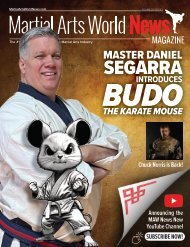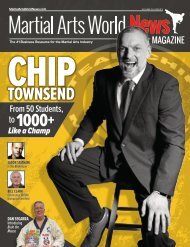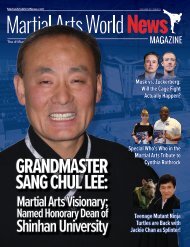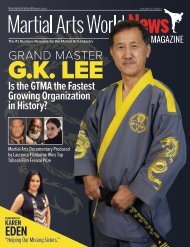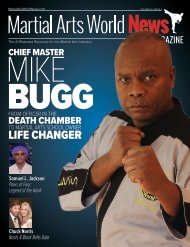Martial Arts World News Magazine - Volume 22 | Issue 2
The #1 Business Resource for the Martial Arts Industry
The #1 Business Resource for the Martial Arts Industry
You also want an ePaper? Increase the reach of your titles
YUMPU automatically turns print PDFs into web optimized ePapers that Google loves.
COVER STORY<br />
MAWN: Master Machado, you have been gracious to spend<br />
some time during the COVID crisis to really help the industry think<br />
a little differently about running a martial arts school and operating<br />
their businesses through this time.<br />
One of the things that you’ve contributed to the industry in a<br />
very meaningful way is that you’ve built a way to teach a robust,<br />
eclectic, and some would say a complex Brazilian Jiu-Jitsu curriculum<br />
to kids, adults who are professionals, seniors, and people<br />
who can’t go to work with a black eye or with broken fingers. What<br />
do you think the ‘magic sauce’ is? Why do you think you’ve been<br />
so successful at teaching?<br />
CM: I have this thought that less is more. And whether it’s kids<br />
or adults, you have one technique. The difference is that for kids I<br />
make the goals more attainable. An adult can think it out and see<br />
things ahead. They might have more expectations. Kids are in the<br />
moment. A lot of people have challenges in terms of keeping the<br />
attention span of the kids, and that’s one of the challenges. Kids<br />
are not about teaching; kids are about show and tell and exciting<br />
them. It’s not so much just the entertaining aspect of the teaching,<br />
because we’ve got to be entertaining to a certain degree, but it<br />
comes to a point that we have to also incorporate the role of an<br />
instructor: input the discipline, input the mindset with a mat chat<br />
and create a structure.<br />
I feel kids are visual and they don’t hear much sometimes because<br />
their attention is not there. They sometimes have a year difference<br />
between one kid and another; a seven year<br />
old to a six year old is like a mountain of difference.<br />
So it’s kind of funny because you’re putting them all<br />
in the same group. I believe you have to hit the endorphins,<br />
so when I teach, the kids are in constant<br />
motion even when they are watching a technique,<br />
because as long as they are focused on their body,<br />
it’s easier for me to keep their minds wherever I need them to be.<br />
If they’re left idle and just listening, it’s really hard. I think, for<br />
instance, other martial arts like Karate and Taekwondo have a<br />
better experience in regards to the teaching aspect because you<br />
Master Machado receives the coveted coral belt in Jiu-Jitsu<br />
do kicks in the air<br />
and you can do all<br />
the demonstrations<br />
with the mirror. The<br />
kids have more<br />
things they can<br />
focus on. But in<br />
Jiu-Jitsu, you have<br />
the instructor and<br />
another training<br />
partner or body<br />
for you to practice.<br />
One teaching<br />
technique I use is<br />
Chuck Norris studied with the Machados and<br />
animals to illustrate different<br />
characteristics that I want them to<br />
rekindled his passion for martial arts.<br />
incorporate.<br />
For example, if I wanted to grab and squeeze, you’re going to<br />
be like an anaconda or a big bear. You start to stimulate the kid’s<br />
imagination.<br />
So how do we integrate that with the curriculum? The curriculum<br />
is kind of streamlined. You have a list of the techniques,<br />
the lesson plan, the warm ups, how much you repeat, how many<br />
minutes you spend on each drill, what intensity of the sparring<br />
and all the rules of engagement. Every school nitpicks what works<br />
best for them, but I think the key here is triggering the imagination.<br />
“…but I think the key here is triggering<br />
the imagination. That’s how I feel I<br />
can get to them the most.”<br />
That’s how I feel I can get to them the most.<br />
We do constant motion. For instance, if I teach my kids how to<br />
do a Jiu-Jitsu guard pass, I break it down into two groups: one half<br />
the passers, the other half the finishers. I teach them, first, how to<br />
be in their position. We do a little running<br />
around, like musical chairs; they<br />
run around and you pick a spot on the<br />
mat. If you don’t do it, you do squats or<br />
push-ups; we make a big deal in a fun<br />
way out of it. Then, I teach them the<br />
rules of engagement.<br />
They’re having fun and understanding<br />
what is asked of them at the same<br />
time. I think the challenge with kids<br />
is not the teaching, it’s how clear the<br />
instruction is for them to interpret. Now,<br />
if there are five to eleven year olds,<br />
the language that I’m explaining in this<br />
illustration is universal. I don’t care what<br />
degree they are or if they have a learning<br />
disability, they’re going to get it.<br />
I have autistic kids and kids that have<br />
handicaps. They still figure things out.<br />
36 MARTIAL ARTS WORLD NEWS VOLUME <strong>22</strong> | ISSUE 2



